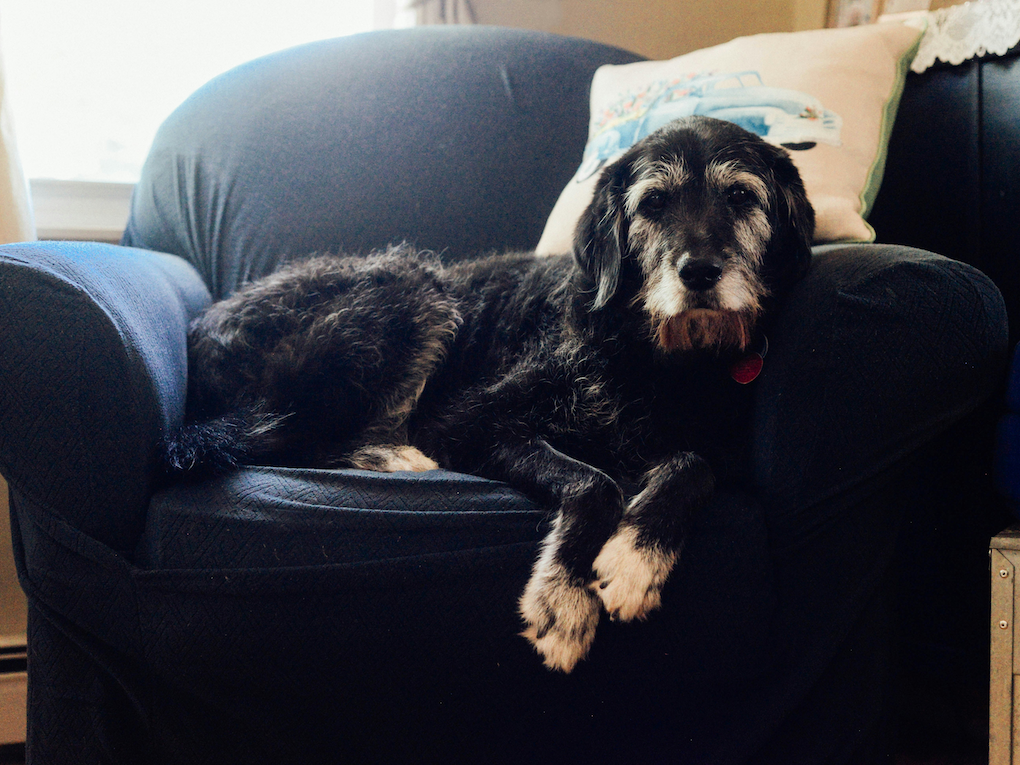Anxiety in dogs is rarely a simple diagnosis. According to the Merck Veterinary Manual, anxiety is a response to fear and agitation, or apprehension when your dog anticipates a scary situation. Fortunately, there are some steps you can take to help your dog cope.
What causes anxiety in dogs?
There are many possible causes of anxiety. Some dogs experience anxiety during specific occasions, such as a trip to the vet, a car ride, or thunderstorms. Others might experience frequent or recurring anxiety. In those cases, it might be harder to identify a specific cause.
Common causes of anxiety include:
- Fear or phobias
- Separation from humans
- Cognitive Dysfunction Syndrome
Types of anxiety in dogs
Veterinarians estimate that ~14% of dogs have separation anxiety, meaning that a dog can’t find comfort when separated from family members. Separation anxiety occurs when a dog is left alone and generally arises in the first 15–30 minutes after humans leave the house.
Fear-based anxiety usually occurs in response to a stressful event or situation. Some types of this kind of anxiety include:
- Fear of other dogs
- Fear of unfamiliar people
- Fear of loud noises or inanimate objects
- Fear of unfamiliar environments
Senior dogs may experience aging-related anxiety associated with Cognitive Dysfunction Syndrome (CDS), the canine version of dementia. With CDS, senior dogs often experience disorientation or confusion as well as pacing, panting, and other signs of anxiety.
Some dogs have a more generalized anxiety, which means they have a fearful reaction to situations that other dogs are unlikely to react to. While there can be a genetic component, previous experiences and other factors also contribute to fear and anxiety.
How to recognize anxiety in dogs
Some signs that your dog is feeling anxious include:
- Whining
- Drooling
- Panting
- Excessive barking
- Pacing
- Destructive behaviors
- Shaking
- Restlessness
- Tucked tail
- Lowered ears
- Lip licking
- Urinating in the house
What to do if your dog is anxious
Finding ways to add consistency and predictability to your dog’s life can help reduce their fear responses. Here are a few methods you can use to help reduce your dog’s anxiety.
1. “Say please”
Training your dog using structured interactions, or “saying please,” can add predictability to their routine. Train your dog to sit or lay down before giving them a treat or toy. Reinforce this habit by having your dog sit or lie down every time you attach their leash, bring them into or out of the car, or do other activities that make them anxious. Your dog will learn that sitting or laying down will earn them a reward. From there, you can gradually work towards longer and more relaxed responses.
2. Use calming vests
Anxiety vests can help your dog calm down during fireworks, thunderstorms, or other stressful situations. These vests apply gentle and constant pressure to soothe anxious pets, similar to swaddling an infant.
3. Try pheromones
Pheromones are chemicals that act like hormones outside the body. Veterinarians recommend Adaptil and ThunderEase (powered by Adaptil) pheromones to help ease anxiety. They imitate the calming pheromones that mothers release to their puppies while nursing, helping your dog feel safer and more comfortable.
4. Add a harness tag
If your dog’s anxiety causes them to be reactive to other dogs or people, consider a harness tag. A note on their harness saying “I’m nervous” lets other people know that they should be considerate of your dog’s personal space and avoid startling them.
5. Create a safe place
If loud noises or other environmental changes make your dog nervous, set aside a designated area where they can go for comfort. Add plenty of toys to keep them busy and other safety cues that can help them feel more comfortable in their spot.
6. Make sure they get regular physical and mental exercise
Make sure your dog is getting enough exercise for their body as well as their brain. While exercise won’t prevent anxiety on its own, regular physical activity and mental stimulation support a dog’s behavioral health. Puzzle toys, dog-friendly tasks, and other brain games can help exercise your dog’s mind and reduce the risk of boredom or anxiety.
7. Consult your veterinarian
If your dog’s anxiety continues, it might be time to talk to your veterinarian. They can advise on your individual situation and might prescribe medication, like fluoxetine, if needed.
If you think your dog is experiencing separation anxiety, try to record their behavior when you leave the house. A video recording can help your veterinarian assess and diagnose their anxiety.
A veterinary behaviorist can also help with behavior modification and training techniques to help your dog cope with anxiety-causing situations. Veterinary behaviorists are trained to address the relationships between a dog’s health, environment, experiences, and their behavior. To find a board-certified veterinary behaviorist, start with the American College of Veterinary Behaviorists.
Ways to prevent anxiety in dogs
While unpleasant, remember that fear is a normal response to stressful situations. By identifying the occasions that trigger anxiety and desensitizing your dog to them, you can teach them that these situations are normal and nothing to be afraid of.





